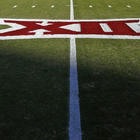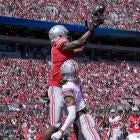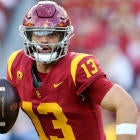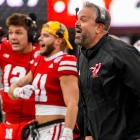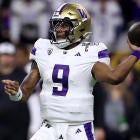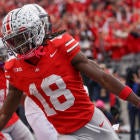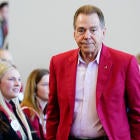PHOENIX -- In 2010, the top four players taken in the NFL Draft were from the Big 12. A former Heisman Trophy winner, Oklahoma's Sam Bradford, topped the list. The league had five of the top six picks with Oklahoma State offensive tackle Russell Okung.
At least in terms of the draft, things had never looked so good. And then came last week. The Big 12 went from having nine players in the first round that in 2010 to 14 overall in 2017.
Let's sharpen the focus: Western Kentucky had as many players taken in the first 72 picks (two) as the Big 12.
What further grabbed headlines was the American Athletic Conference out of the Group of Five having more draft picks (15) than the Big 12 out of the Power Five.
"I don't know if I have a reaction to it," Big 12 commissioner Bob Bowlsby said during a break in the conference's spring meetings last week. "We've had years when we've had a lot. We've had years when we haven't had many. I guess it's not astonishing."
Actually, the astonishing thing is how far the Big 12 has sunk in terms of perception, talent and … winning. We can debate everything from revenue to recruiting, but what can't be argued is image.
The Big 12's is not good at the moment. Type the words "Big 12" on Twitter and mostly vitriol is shot back. What was once celebrated is now defended.
It is the only league to miss the three-year-old College Football Playoff twice. It is the only Power Five league not to win a CFP game.
Last year in Phoenix, there was a hair-on-fire feel to the spring meetings as expansion talk started in earnest. The league went thorough a laborious, extensive and -- some think -- divisive process that ended up fruitless in October.
The Big 12 stayed at 10.
Perception has become reality in a parallel universe. The Big 12 could have countered the bad draft news with the fact it was coming off a 2016 season that produced two Heisman finalists and three teams ranked in the top 18 of the final Associated Press Top 25 for a fourth consecutive season.
It didn't, leaving the likes of Texas' Tom Herman to offer this analysis.
"It is irrelevant what conference you played in," Herman said. "It is irrelevant what school you went to. It's … did God bless you with enough God-given talent? Did you take the initiative to maximize that talent? Were you around coaches and support staff that gave you the tools and the resources and instruction to develop that talent?"
Conference realignment -- as well as a talent exodus -- has conspired against the Big 12 lately. Start with the fractionalization of the conference's recruiting hub in the state of Texas.
The loss of Nebraska, Colorado, Missouri and Texas A&M in realignment meant 170 native Texas recruits have matriculated to those four schools in the Big Ten, Pac-12 and SEC since 2011.
That's the equivalent of almost seven Texas-only recruiting classes that could have ended up in the Big 12. Make no mistake, the Big 12's strength revolves around Lone Star State recruiting.
"The [recruiting] hole in the fence in the state of Texas is real," said Barton Simmons, director of scouting for 247Sports.
The Big 12 remains the smallest FBS conference (10 teams). Twenty-one years ago, the reason the league was assembled in the first place -- the power of Texas and Oklahoma -- is part of the reason it is struggling now.
According to the 247Sports Composite rankings, Oklahoma hasn't signed a top-10 recruit from the state of Texas in four years. Herman signed Texas' "worst" recruiting class since rankings were established in 1990. Herman called it a "transitional" year in recruiting after his class finished 26th.
"It's still one of the best academic schools in the country," Herman said. "It's still in Austin, the No. 1 city in America to live in. It has a fan base and resources that have been proven to be able to win championships on a consistent basis."
Herman's arrival has raised hopes a turnaround is imminent. Bob Stoops continues to win conference titles. But Texas hasn't appeared in a major bowl since the 2009 title game (the 2010 Rose Bowl). It is also the last Big 12 school to win a national championship -- in 2005.
Baylor and TCU have risen up in recent years, but the relative strength of the Big 12 is based on the fortunes of Texas and Oklahoma.
"A problem is that Texas needs to be good," Herman said. "It's not the problem."
The draft, though, has reflected a dramatic slide in Big 12 fortunes. In 2011, the league "slipped" to having three picks in the top 10. That number shrunk to two in the first round each in 2014 and '15.
After getting three first-rounders in 2016, the Big 12 sunk to one player taken in the top 47 -- Texas Tech quarterback Patrick Mahomes.
"That's not our job -- to be a farm league," Herman said. "It's like I tell kids in recruiting: 'It doesn't matter if you play at a 1A high school or a 6A high school, if you're good enough to play at Texas we'll find you.'
"The same thing goes for college. If you're good enough to play in the NFL, they'll find you."
Increasingly, those players are hard to find in the Big 12. Much has been made about the exodus from the Texas recruiting hub. That migration is real and has been well chronicled by CBS Sports.
No, it's not college football's job to be a farm league. But the truth is that's how many teams and conferences measure their success. It's no coincidence the SEC continues to be the dominant league. It led college football with the most draft picks (53) for the 10th straight year and set a record for most drafted in the first two rounds (21).
The 2017 draft isn't necessarily the problem for the Big 12. It's 16- and 17-year-old future recruits forming a perception of the Big 12 in a series of down draft years.
"There's something to that," Simmons said. "It's less a disadvantage to the Big 12 and more an advantage to other conferences. … There's a lot of negative noise around the Big 12. It's a lot of little things that make up the big picture."
Stoops has won 10 Big 12 titles and continues to land top recruiting classes while producing NFL players -- at least four each year since 2004. Since 2005, OU has averaged almost 5 1/2 draftees per year.
From 2005-15, Oklahoma had the fourth-most players drafted (63). Texas tied for 10th in that span with 46. But that included 2014, a year in which no Longhorn was taken for the first time in 77 years.
The state of Texas produces about 250 Division I players each year. Combine Texas with California and Florida, and the other 47 states aren't even close.
"We'd rather they stayed in [Texas], but they aren't always going to," Bowlsby said. "The competition is hot and heavy, and we've got to compete for them.
"I don't think we can make the assumption that just because they're from Texas they're going to stay in the Big 12. We can't make the assumption that just because they're from Texas they're going to stay in Texas."
Texas is off to a great start recruiting the Class of 2018, according to 247Sports. Based on projections, the Big 12 could have at least five first-round picks next year.
"The talent issue is easily correctable if Texas gets back," Simmons said.
Short of expansion, the Big 12 decided last summer to restart its championship game in 2017. For the first time since the start of the BCS era in 1998, the two best teams from a conference are guaranteed to meet.
It's a high-risk, high-reward move. The Big 12 is guaranteed a regular-season rematch. In its previous iteration, the league's championship was the most volatile of the power conferences.
Six times in 15 years, the point-spread underdog either covered or won outright. Due to upsets, the Big 12 lost BCS title game contenders in the 1996, '98 and 2007 seasons.
Research by CBS Sports showed that matching the Big 12's top two teams from 1996 to 2010 (instead of having the division winners meet) would have made little difference in that volatile era.
"We've been hurt by the double-edge sword more than anybody else," Bowlsby said. "We've had several high-ranked teams that have been beat. We decided, if we were going to do it, we were going all in."
Research by Big 12 consultants shows the odds of a team winning both games in a rematch scenario is small. But the league considers it is in a better place.
Without a championship game in 2011, Oklahoma State was nipped by Alabama in the BCS. In 2014, co-champs Baylor and TCU were left out of the playoff.
In the FBS' previous 76 conference championship games (to 1992), upsets have occurred approximately 30 percent of the time.
With all the negativity, there is open conversation about how long the Big 12 will last and whether schools like Kansas and Kansas State will remain in a major conference. The only certainty is that whatever college football looks like in the next decade, Texas and Oklahoma will be just fine.
By 2020, Texas could be nearing $60 million in annual media rights revenue given Big 12, Longhorn Network, CFP and NCAA Tournament income. Oklahoma will be close to that figure thanks to an agreement with Fox Sports Southwest for its third-tier rights.
Bowlsby said Texas makes more from its "media properties" than any school in the country.
Either school probably won't leave anytime soon given that revenue windfall and a Big 12 binding grant of rights. But the biggest reason is competition itself.
Despite the downturn, the Big 12 remains the best place for Texas and Oklahoma to win championships. They simply wouldn't wield their Big 12 power elsewhere.
If OU left today for the SEC, its officials would walk into conference meetings with Alabama, Auburn, LSU, Florida, Georgia and Tennessee (among others). Think of Texas in the Big Ten. Michigan and Ohio State have been the big dogs there for decades.
But the decision for Texas and Oklahoma to leave might be inevitable. The consolidation of power -- outside the Big 12 -- continues.
Urban Meyer sent a shiver through Big 12 country in February when he walked into Texas on National Signing Day and landed three of the state's top six prospects.
That had never happened before. It might become a regular occurrence.
"We'd rather they stay in the Big 12 footprint and go to our schools …," Bowlsby said. "Everybody comes into Texas. There are going to be people that leave. We need to be better keeping the best ones home."












